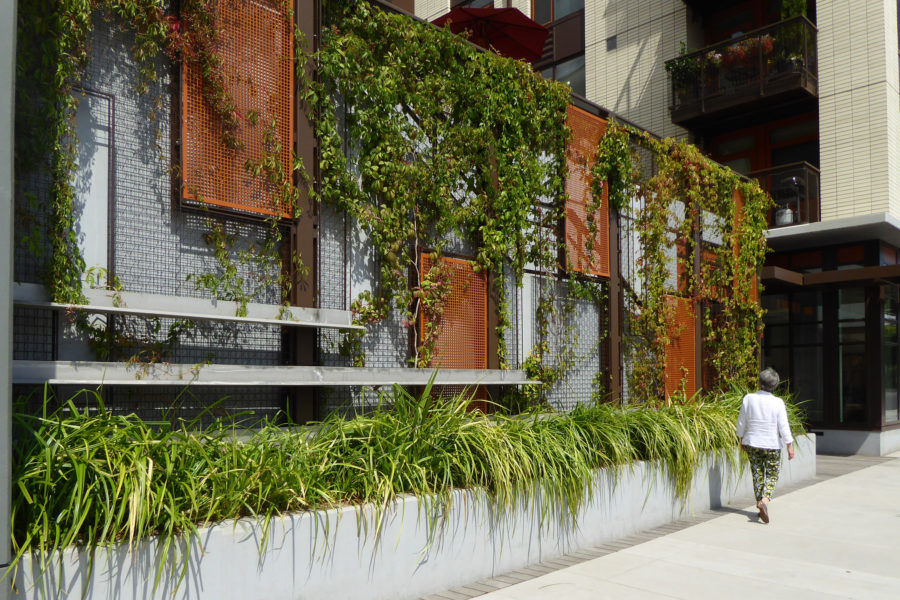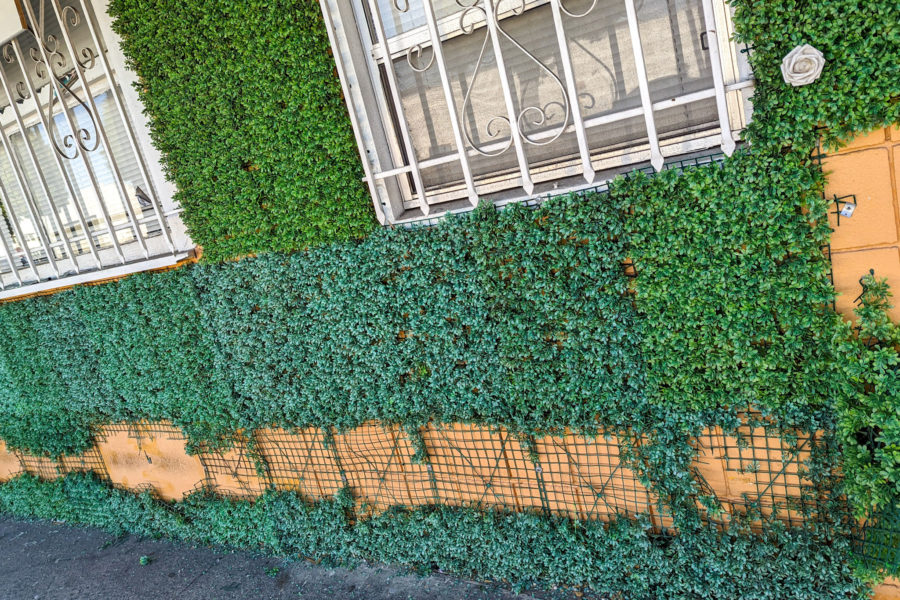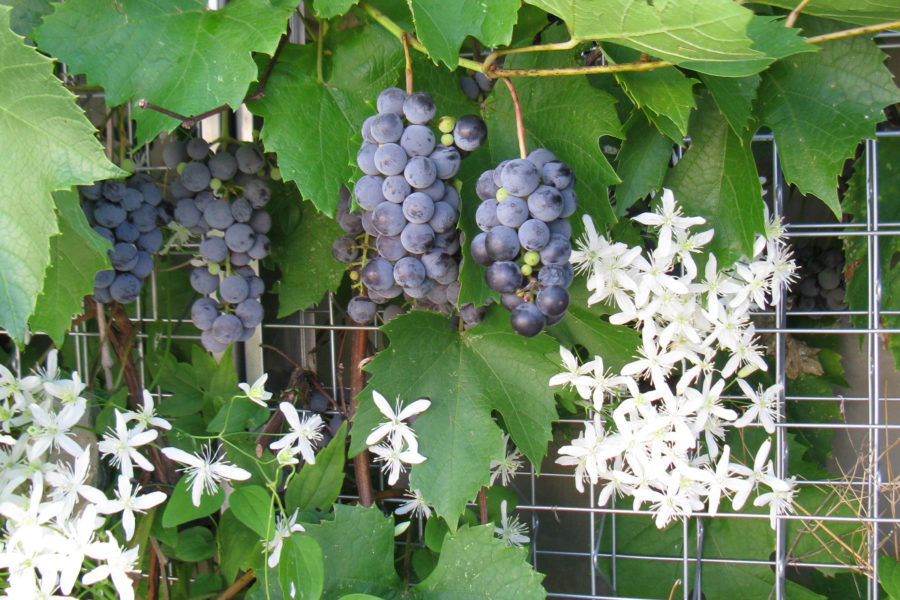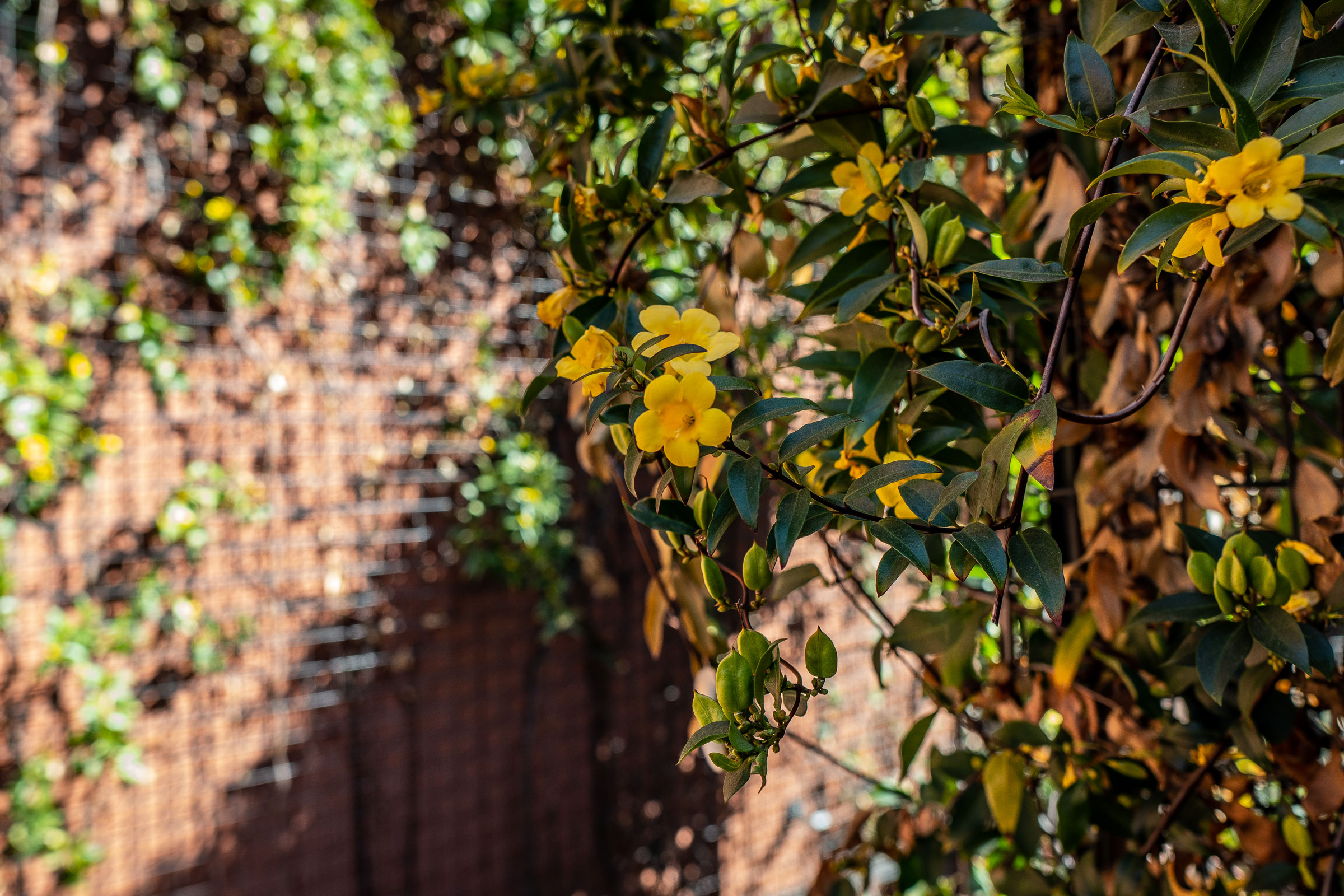Story at a glance:
- Real green infrastructure does more than provide decoration.
- Live plants help to fight urban heat islands and flooding
- Green infrastructure can also reduce pollution.
Modern artificial plants can look amazing. The technology has come a long way from Granny’s sun-bleached silk plants. Textures and colors can be incredibly lifelike and sometimes include reflective properties to give an even more natural touch. But they are still artificial and should never be confused with real green infrastructures and what they can provide.
While I don’t have an issue with artificial plants used for merely decorative purposes in a home or hospital where natural vegetation may not be allowed, I think it’s troublesome (and dated) when sorely needed green infrastructure is replaced with plastic. In many cases there has largely been a misunderstanding of what green infrastructure is and its purpose.
Sure, green infrastructure is also decorative; urban nature can be a wonderful thing for the eye, but there is so much more to it. Proper green infrastructure is a workhorse (a pretty workhorse nonetheless) that will enable livable conditions in our future cities.
Today we face some of humanity’s most significant challenges—battling urban heat islands, erratic weather, flooding, and disease. We need green infrastructure and not just something that looks like it.
Stormwater and Cooling

Grays Landing in Portland, Oregon. Photo courtesy of greenscreen
What can true green infrastructure provide? Stormwater management is a critical aspect due to our changing climate. Our urban areas are at significant risk for water insecurities with both too little and too much water, caused by droughts and flooding.
Green roofs and walls can capture a significant portion of the annual precipitation, around 30 to 70% annually for extensive green roofs depending on climate and design. This leads to a massive reduction of the water that enters the combined sewer systems and less tax money spent on cleaning said water in sewage treatment plants. This is a big financial benefit for the municipalities.
The retained water is evapotranspired and returned to the sky as water vapor. If you have ever walked across a meadow and suddenly stepped onto the asphalt road on a hot summer’s day, you have experienced how vegetation can cool and how hot stone and asphalt can become. The plant evapotranspiration process is a highly efficient cooling “engine” and essential for our current and future urban dwellings, especially as urban temperatures continue to rise significantly over the coming years.
But this is not all, outdoor vegetation can also cool the insides of a building. This can be done using green roofs or green wall systems like the trellis systems from greenscreen. The shading is one factor but far from all. The evapotranspiration process buffers the building from the outdoor heat. The air conditioning vents take in cooler air saving energy, and money and positively affecting the carbon budget.
It might be worth noting that R or U-values, measures of thermal resistance and thermal transmittance respectively that are used as building energy ratings, are poor measures of the green walls and roofs, as these are determined at the worst possible scenario, and the living part of the system is not considered. Energy modeling is a preferred method to assess actual money saved for building cooling for living systems.
Artificial plants do not evapotranspire and cannot provide any of these benefits and possible cost savings.
In addition, when you bring a green roof stormwater detention system to the table you can get rid of sizable space constraining stormwater tanks at grade level and create floor space for potential income generating use.
Air Pollution Capture
Air pollution is the fourth leading global risk factor for death. There are a number of different dangerous air pollutants, but one that sticks out as particularly harmful is PM2.5—a small inhalable particle with a diameter of less than 2.5 micrometers. PM2.5 significantly contributes to respiratory and cardiovascular disease. In 2019 86% of the urban world population (2.5 billion people) was exposed to PM2.5 levels exceeding the WHO guidelines resulting in over 1.8 million deaths yearly.
Nearly everyone in urban areas is exposed to harmful air pollution. To alleviate this problem source reductions are a must—ensuring efficient capture of the PM2.5 and other pollutants that are still released. Green infrastructure can do this. Plastic plants do not.
Research has shown that green walls and facades appear to be good air pollution mitigants, as they can cover the sides of high-rise buildings without trapping air at street level. One scientific study showed that only by greening the building walls, harmful PM2.5 and NO2 could be reduced by 11 to 31% and 7 to 20% respectively, which underlines the importance of green walls in mitigating air pollution.
A proven and highly effective method of pollution capture is the use of green walls as a barrier between traffic, pavement, and housing. The barrier results in a significant drop in the toxic particle concentration, often as much as 50%. Several factors are to be considered—including wind speed and direction, species, humidity, and barrier dimensions—to achieve the best result.
We should be aware that there is significant variation between green infrastructures in how well they capture fine particulate matter. Poorly placed trees in urban canyons can lead to the increase of at-grade PM2.5 levels as the canopy can trap the pollutants at street level. Please note that this is not a case against trees; trees are critical for our urban environment. It is merely a case of the correct positioning of trees in street canyons.
The Environmental Footprint of Artificial Plants

Artificial vine located in Downtown LA. Photo courtesy of greenscreen
Artificial plants are often made from hydrocarbons, which negatively affect the carbon footprint. Natural vegetation binds carbon dioxide and hence has the potential to achieve a favorable carbon budget. However, even a green roof or wall has a specific carbon payback time for the whole life cycle.
According to research, the carbon payback time for an extensive green roof is 6 to 16 years, depending on the species, profile, and irrigation requirements. This shows that extensive green roofs contribute to carbon dioxide reduction within their lifespan, estimated to be at least 40 to 50 years. However, this study should be seen as a carbon budget worst-case scenario, as the grasses used in the study had already reached their equilibrium.
Even faster carbon payback can be expected from green wall systems, especially with climbing woody plants that accumulate carbon in their biomass year after year.
Sensible Uses for Artificial Plants
Are there sensible uses for artificial plants? Yes, I think there are. I talked a bit about that in my previous article on biophilic design, where I also discussed whether artificial plants are biophilic. I think it very much depends on the situation and location. If a well-constructed artificial plant decorates an MRI room, for example, I think of it positively. This is mainly because natural plants are not allowed in an MRI room, and that space would be too dark for them to survive. The artificial plant would at least bring calming biophilic elements to the place, though we could not refer to this as a true biophilic design, as that would require many more interlinked and connected elements.
An MRI room also has no urban heat islands, no missed ROI opportunity regarding stormwater, and no biodiversity to support. In this situation I feel an artificial plant is the right thing for the right place.
I previously found an article called “Enhance your Lawn with the Best Artificial Plants.” I am sure the writer meant well, but where have we ended up as a society when the solution to a monocultural lawn is to add plastic flowers instead of bringing back beautiful and needed biodiversity in the form of things like urban meadows?
Urban meadows are used in my hometown of Berlin and have brought substantial benefits. In the beginning many voices claimed this would bring animal pests into the city. This has shown to be a flawed assumption. Food and wrappers attract pests like rats, but the introduction of more wildlife into the city has acted as a pest-controlling agent. For example, hedgehogs eat slugs and snails, ladybirds eat aphids, and foxes eat rats. Low maintenance, attractiveness, and biodiversity are among the great benefits of urban meadows.
Every day in summer I see schoolchildren walking through the meadows learning about plants and nature. The mowed lawns are often brown and half-dead as summer progresses, whereas meadows remain cool, pleasant, and beautiful. Natural additions do not have to be high maintenance, and they most definitely do not need to be made of plastic.
Longevity of Artificial Versus Natural Plants

Whole Foods in Boulder, Colorado. Photo courtesy of greenscreen
About 2,000 years ago climbing plants were used to cool the backyards of houses in the Mediterranean region. These climbing plants also produced shade and provided fruits with economic value. The benefits of planted vertical walls have been known for awhile. Move forward many centuries, and green infrastructure is used to cool factory buildings in central Europe. Still, on old buildings, you will find thriving and beautiful climbing plants creating a lush and cool environment. These are old plants, and they look fantastic.
Artificial plants are getting more resistant to UV degradation and can look good, but we can never compare a natural vegetated trellis wall after 10 years with an artificial wall of the same age. Nature grows and flourishes; it is alive, whereas the artificial wall only degrades. Of course, there is maintenance required for the natural plant wall, but it is a workhorse and can lead to savings in other areas like cooling and stormwater. Nonetheless, it is critical that a clear green infrastructure maintenance agreement is implemented and that the provider communicates the yearly maintenance costs. However, it is also essential to be clear on the cost savings (ROI) the green project will bring.
What about Christmas Trees?
One interesting plastic plant example that irked me is that of Christmas trees. This is something I have pondered for awhile and have had a few heated dinner table debates over. Note that this example involves cut vegetation and should not be compared with live green infrastructures. But are fake Christmas trees better than real ones? I was very disappointed that surprisingly little research has been done in this field. However, in general, it appears to be more environmentally friendly in the short run to purchase a real Christmas tree, and the fake ones become more environmentally “friendly” the longer you keep them. Sadly, many artificial trees end up in landfills contributing to our microplastic problem, whereas the real trees are mostly composted or mulched.
I personally rent a tree in a pot that is returned to the tree company and re-rented the following year. The carbon budget of this was impossible to determine, so I will live within my anecdotal assumption that I am doing something good, but the reality is I have no idea. Dried plants are, of course, the eco-friendlier third option but will not hold up to the elements, and a dried Christmas tree just doesn’t have that holiday feel.
In summary, plastic plants are, in my opinion, dated, not environmentally friendly, and not a positive way forward unless placed in a completely dark room or in a clean environment like an MRI room at a hospital where real plants are not allowed.


